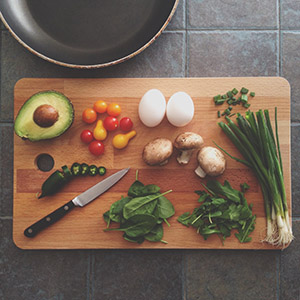[su_dropcap style=”simple” size=”5″]C[/su_dropcap]ooking techniques and ingredients vary widely across the world, from grilling food over an open fire to using electric stoves, to baking in various types of ovens, reflecting unique environmental, economic, and cultural traditions and trends. The ways or types of cooking also depend on the skill and type of training an individual cook has. Cooking is done both by people in their own dwellings and by professional cooks and chefs in restaurants and other food establishments. Cooking can also occur through chemical reactions without the presence of heat, such as in ceviche, a traditional South American dish where fish is cooked with the acids in lemon or lime juice.
Preparing food with heat or fire is an activity unique to humans. It may have started around 2 million years ago, though archaeological evidence for it reaches no more than 1 million years ago.
The expansion of agriculture, commerce, trade and transportation between civilizations in different regions offered cooks many new ingredients. New inventions and technologies, such as the invention of pottery for holding and boiling water, expanded cooking techniques. Some modern cooks apply advanced scientific techniques to food preparation to further enhance the flavor of the dish.
Ingredients
Most ingredients in cooking are derived from living organisms. Vegetables, fruits, grains and nuts as well as herbs and spices come from plants, while meat, eggs, and dairy products come from animals. Mushrooms and the yeast used in baking are kinds of fungi. Cooks also use water and minerals such as salt. Cooks can also use wine or spirits.
Naturally occurring ingredients contain various amounts of molecules called proteins, carbohydrates and fats. They also contain water and minerals. Cooking involves a manipulation of the chemical properties of these molecules.

Carbohydrates
Carbohydrates include the common sugar, sucrose (table sugar), a disaccharide, and such simple sugars as glucose (made by enzymatic splitting of sucrose) and fructose (from fruit), and starches from sources such as cereal flour, rice, arrowroot and potato.
The interaction of heat and carbohydrate is complex. Long-chain sugars such as starch tend to break down into simpler sugars when cooked, while simple sugars can form syrups. If sugars are heated so that all water of crystallisation is driven off, then caramelization starts, with the sugar undergoing thermal decomposition with the formation of carbon, and other breakdown products producing caramel. Similarly, the heating of sugars and proteins elicits the Maillard reaction, a basic flavor-enhancing technique.
An emulsion of starch with fat or water can, when gently heated, provide thickening to the dish being cooked. In European cooking, a mixture of butter and flour called a roux is used to thicken liquids to make stews or sauces. In Asian cooking, a similar effect is obtained from a mixture of rice or corn starch and water. These techniques rely on the properties of starches to create simpler mucilaginous saccharides during cooking, which causes the familiar thickening of sauces. This thickening will break down, however, under additional heat.
Fats
Types of fat include vegetable oils, animal products such as butter and lard, as well as fats from grains, including corn and flaxoils. Fats are used in a number of ways in cooking and baking. To prepare stir fries, grilled cheese or pancakes, the pan or griddle is often coated with fat or oil. Fats are also used as an ingredient in baked goods such as cookies, cakes and pies. Fats can reach temperatures higher than the boiling point of water, and are often used to conduct high heat to other ingredients, such as in frying, deep frying or sautéing. Fats are used to add flavor to food (e.g., butter or bacon fat), prevent food from sticking to pans and create a desirable texture.
Proteins
Edible animal material, including muscle, offal, milk, eggs and egg whites, contains substantial amounts of protein. Almost all vegetable matter (in particular legumes and seeds) also includes proteins, although generally in smaller amounts. Mushrooms have high protein content. Any of these may be sources of essential amino acids. When proteins are heated they become denatured (unfolded) and change texture. In many cases, this causes the structure of the material to become softer or more friable – meat becomes cooked and is more friable and less flexible. In some cases, proteins can form more rigid structures, such as the coagulation of albumen in egg whites. The formation of a relatively rigid but flexible matrix from egg white provides an important component in baking cakes, and also underpins many desserts based on meringue.
Water
Source: Wikipedia











Lorem ipsum dolor sit amet, consectetuer adipiscing elit, sed diam nonummy nibh classica ed euismod tincidunt ut laoreet dolore magna vertolori. Claritas est etiam processus dynamicus, qui sequitur.
Lorem ipsum dolor sit amet, consectetuer adipiscing elit, sed diam nonummy nibh classica ed euismod tincidunt ut laoreet dolore magna vertolori. Claritas est etiam.
Lorem ipsum dolor sit amet, consectetuer adipiscing elit, sed diam nonummy nibh classica ed euismod tincidunt ut laoreet dolore magna vertolori.
This is a short comment.
Lorem ipsum dolor sit amet, consectetuer adipiscing elit, sed diam nonummy nibh classica ed euismod tincidunt ut laoreet dolore magna vertolori. Claritas est etiam processus dynamicus.
Investigationes demonstraverunt lectores legere me lius quod ii legunt saepius. Claritas est etiam processus dynamicus, qui sequitur mutationem consuetudium lectorum. Mirum est notare quam littera gothica, quam nunc putamus parum claram. Duis autem vel eum iriure dolor in hendrerit in vulputate velit esse molestie consequat.